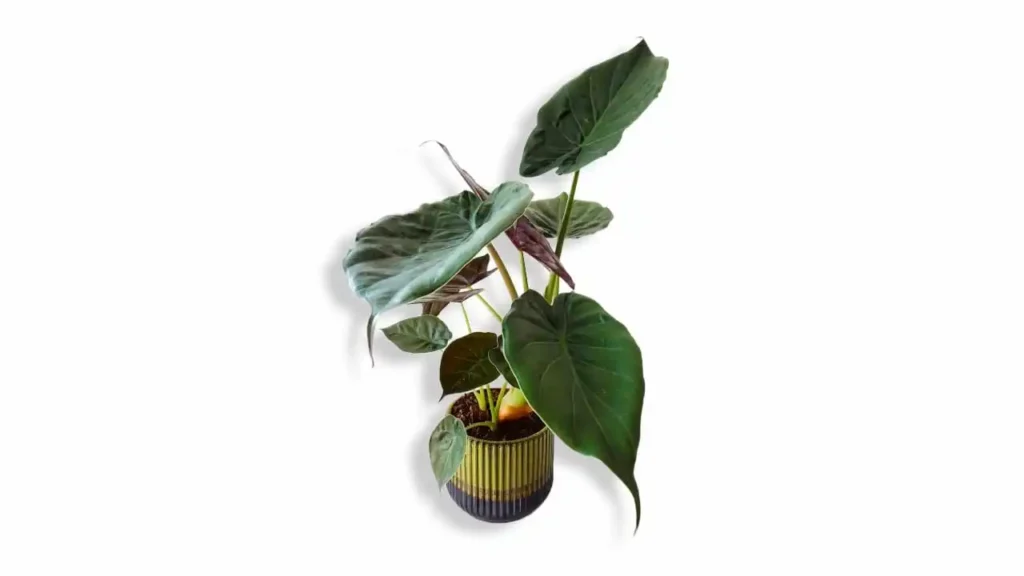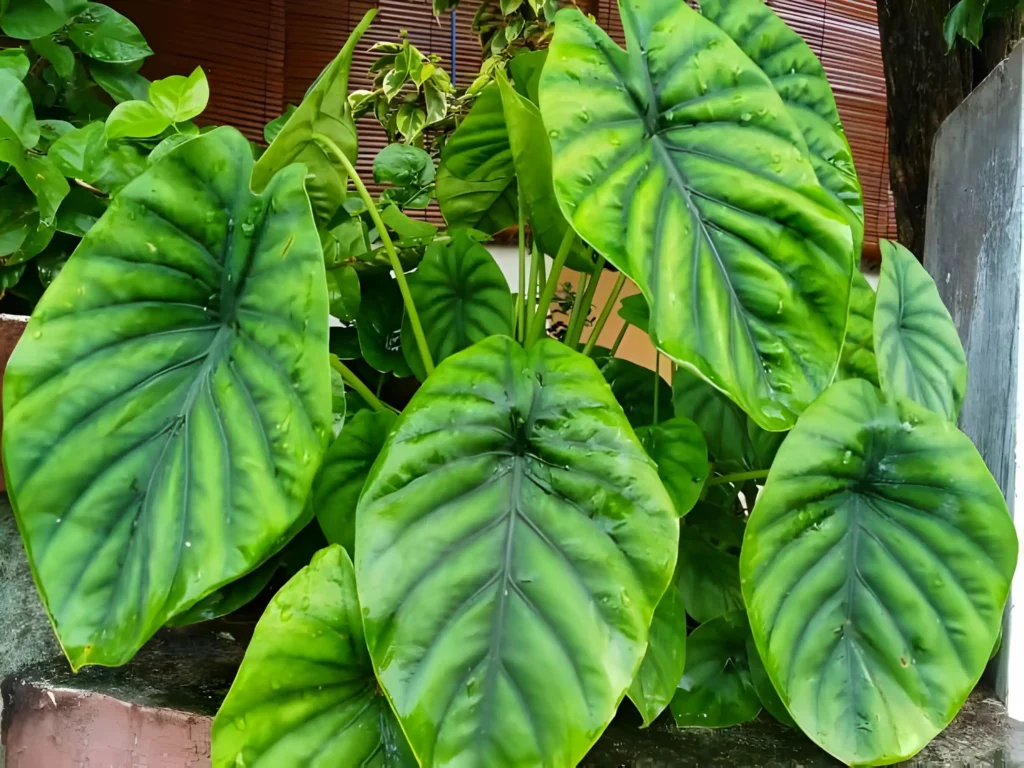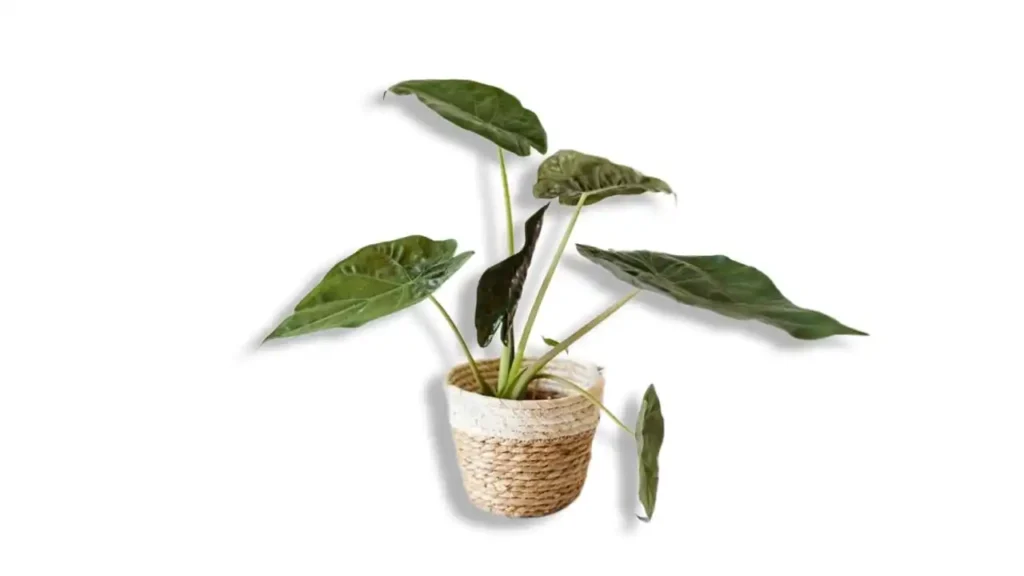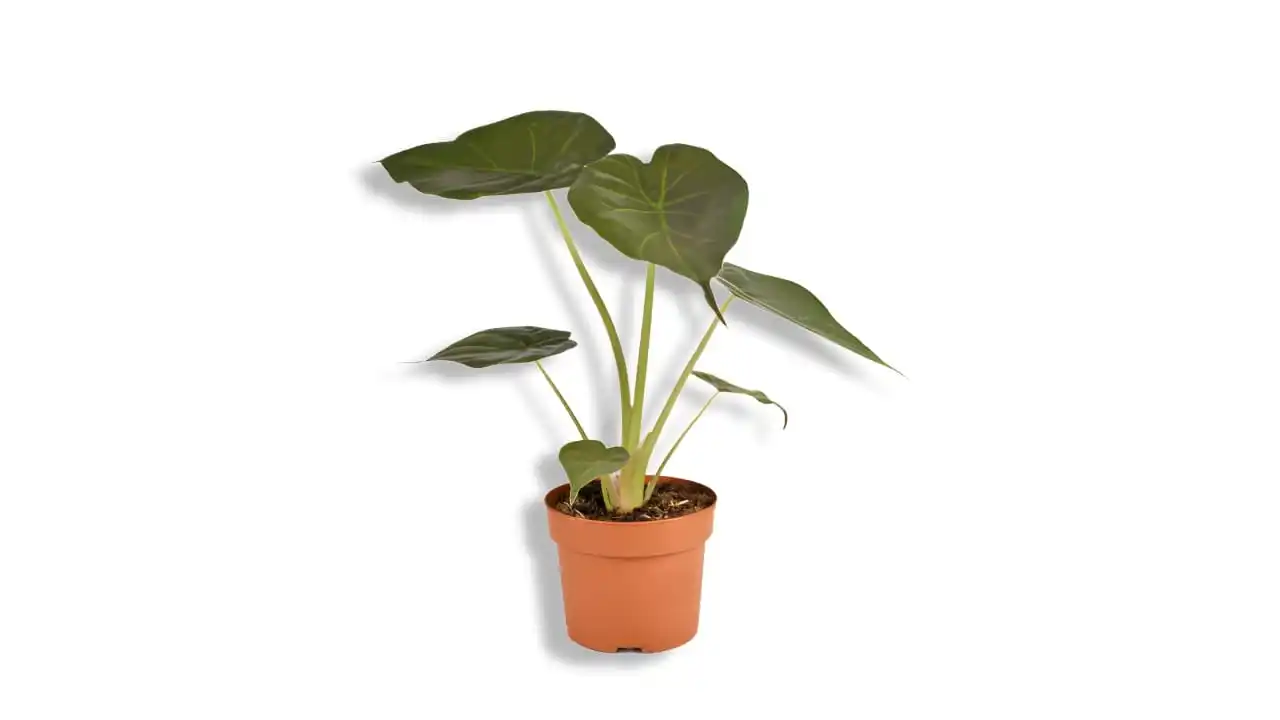Introduction
Alocasia Wentii, commonly known as the ‘Hardy Elephant Ear,’ is a stunning tropical plant celebrated for its unique foliage. Originating from the rainforests of Southeast Asia, this plant boasts large, arrow-shaped leaves with striking silver veins, making it a favorite among plant enthusiasts.
Quick Overview
| Common Name | Hardy Elephant Ear, New Guinea Shield |
| Scientific Name | Alocasia Wentii |
| Sun Exposure | Partial |
| Soil Type | Well-Drained, Moist |
| Soil pH | Acid, Neutral, Alkaline |
| Family | Araceae |
| Mature Size | Up to 5 Ft. Tall Indoors And 10 Ft. Tall Outdoors |
| Plant Type | Herbaceous, Perennial |
| Native Area | Asia |
| Toxicity | Toxic to Pets And People |
The Origin of Alocasia Wentii
Native to the rainforests of Borneo, Alocasia Wentii thrives in warm and humid conditions. Its natural habitat provides the ideal environment for this plant to grow vigorously, showcasing its vibrant leaves and adapting to the surrounding ecosystem.
Unique Features of Alocasia Wentii
One of the standout features of Alocasia Wentii is its robust leaves that can grow up to 2 feet long, creating a dramatic presence in any space. The silver veins running through the deep green foliage add a touch of elegance, making it a centerpiece in any garden or indoor setting.

Read Me – Alocasia Sarian: The Ultimate Care And Growing Guide
Caring: Nurturing For Your Alocasia Wentii
Caring for your Alocasia Wentii mirrors the delicate art of nurturing a precious jewel – it blossoms under vigilant guardianship. Let’s explore the pivotal elements to guarantee this verdant gem’s prosperity!
Watering: Striking the right equilibrium in watering your Alocasia Wentii is paramount – neither too lavish nor too frugal, but impeccably moderate. Permit the superficial soil stratum to desiccate before hydrating, ensuring the roots remain neither arid nor saturated.
Light: Although your Alocasia Wentii yearns for luminous environs, it’s prudent to shield it from the harsh glare of direct sunbeams to avert leaf scorching. Periodically reposition the plant to promote uniform expansion and deter it from inclining towards its luminous fountain.
Humidity: Mimicking its indigenous milieu, your Alocasia Wentii revels in humid climes. Indulge it with intermittent misting interludes to amplify moisture content, particularly if your abode veers towards aridity. Ponder positioning a vessel filled with water and pebbles beneath the receptacle for supplemental humidity.
Fertilization: Throughout its robust growth phase, furnish your Alocasia Wentii with a diluted, harmonious nutrient solution bi-weekly. This enriching protocol will sustain its verdure and vitality, reminiscent of bestowing it with a vitamin infusion.
Pruning: Extend your plant the grace of meticulous pruning, excising any shriveled or marred foliage. This practice not only upholds its visual allure but also invigorates nascent sprouting. Remember to wield sanitized shears to forestall contagion dissemination.
Periodic Care Perspectives
Spring & Summer: These epochs are jubilant fiestas for your Alocasia Wentii! Lavish it with frequent misting to uplift its morale and strictly adhere to a rhythmic hydration and nourishment cadence. Maintain a vigilant watch for invaders and expediently rectify any infestation indicators.
Autumn & Winter: As the mercury descends, your verdant companion embraces a dormant phase. Refine your hydration regimen to circumvent excessive saturation and allocate a snug niche for your plant, insulated from frigid currents. Though demanding diminished attention, sporadic pampering is ardently cherished.
By bestowing your Alocasia Wentii with an impeccable fusion of humidity, luminosity, and attentive care across the seasonal tapestry, you shall cultivate a robust and gratified specimen exuding tropical allure within your sanctuary!

Propagation: An Insightful Exploration into Plant
Ever pondered the idea of cultivating additional Alocasia Wentii specimens from your cherished one? Embarking on the journey of propagation offers a captivating avenue for this endeavor. Whether your aspiration leans towards enriching your botanical haven indoors or gifting the allure of this tropical marvel to acquaintances, delving into Alocasia Wentii propagation is an enriching venture. Let’s explore the nuanced techniques of propagation: division and stem cuttings.
The Division Technique
The process of propagation via division mirrors rejuvenating your Alocasia Wentii. Herein lies the methodical approach:
- Preparation of Your Specimen: Tenderly extract your Alocasia Wentii from its container, gently dislodging residual soil to unveil its intricate root architecture.
- Identification of Organic Divisions: Scrutinize your plant meticulously to discern areas primed for natural bifurcation. Each segment should boast a substantial cluster of foliage accompanied by a root system.
- Segmentation with Precision: Utilizing a pristine blade or shears, meticulously divide your specimen into more manageable portions, ensuring each fragment retains its unique root structure and a cluster of leaves.
- Cultivation of the New Segments: Transplant each segment into individual containers filled with porous soil. Administer ample hydration and position them in a temperate, moisture-rich environment to facilitate acclimatization.
The Stem Cutting Approach
Desiring to foster new Alocasia Wentii offshoots from a solitary stem? Here’s a comprehensive guide:
- Selection of a Robust Stem: Identify a stem featuring a node, the pivotal juncture where nascent roots will emerge. Typically, nodes manifest at the nexus of leaves and the stem.
- Execution of the Cutting Process: Employ sanitized scissors or shears to sever the stem just beneath a node, targeting a segment spanning approximately 4-6 inches.
- Refinement of the Cutting: Eliminate the basal foliage to expose the node, enhancing root initiation from this critical point.
- Implementation of the Cutting: Immerse the cutting into a diminutive vessel filled with moistened soil, ensuring the node remains submerged while the cutting maintains an upright posture. Incorporating a rooting stimulant can amplify its growth trajectory.
- Nurturing the Cutting: Maintain the cutting in a temperate, humid ambiance with diffused illumination. Sustain soil moisture without inducing saturation, intermittently misting to preserve optimal humidity levels.
In conclusion, armed with these intricate techniques, augmenting your Alocasia Wentii assortment becomes a feasible endeavor. Whether you’re an adept horticulturist or a novice embarking on a verdant odyssey, Alocasia Wentii propagation emerges as a gratifying medium to foster a deeper connection with the botanical realm and disseminate the ecstasy of cultivation. Prosperous propagating!

Potting & Repotting: The Alocasia Wentii Abode
So, you’ve acquired an Alocasia Wentii, and its domicile is now your pondering puzzle? Let’s delve into the art of bestowing your verdant companion with an exquisite habitat, navigating the nuances of potting and repotting with finesse!
Selecting the Optimal Vessel
Visualize your Alocasia Wentii as the arboreal connoisseur—it demands a receptacle of impeccable dimensions! Opt for a vessel marginally grander than its present abode. This ensures ample legroom for its roots to luxuriate. And never underestimate the significance of drainage apertures; they are the plant’s vigilant guardians against unwelcome water retention.
Deciphering the Repotting Signs
Much like an adolescent outgrows attire, your Alocasia Wentii signals when evolution beckons. Detect cues of its snug confinement—perhaps its roots hinting, or it appears somewhat congested. Recognizing these indicators heralds the necessity of repotting.
The Repotting Odyssey
Eager to grant your Alocasia Wentii a verdant horizon? Embark on this meticulous journey with a methodical blueprint:
- Preliminary Plant Indulgence: Commence by offering your plant a revitalizing libation. This eases its transition from its former abode. Meanwhile, prepare its novel domicile with pristine, permeable soil at its base.
- The Grand Relocation: Tenderly upend your Alocasia Wentii from its preceding pot, cradling its foundation throughout. Should the roots appear ensnared, afford them a gentle oscillation to liberate them.
- Root Examination: Cast an eye upon those tendrils! Detect any soft or discolored segments? Snip them off with incisive, hygienic shears. Prudent pruning at this juncture averts future complications!
- Novel Abode, Renewed Vistas: Nestle your Alocasia Wentii within its novel pot, ensuring its alignment mirrors its prior orientation. Close the interstices with untainted soil, offering a soft compression to stabilize the ensemble.
- Hydration Interval: Submerge your plant in a generous aqueous embrace. This aids in soil consolidation and quenches the roots’ thirst. Allow residual moisture to dissipate, then locate a locale bathed in muted luminance for your plant’s acclimatization.
Post this endeavor, maintain vigilant surveillance over your Alocasia Wentii. It may require a transitional period to acclimate. Yet, with ardor and attentiveness, your verdant companion shall reciprocate with opulent foliage and resplendent leaves!

Pests & Diseases: Nurturing Alocasia Wentii’s Well-being
Alocasia Wentii, akin to humans, confronts health adversities, predominantly stemming from intrusive pests and ailments. Fear not! Diligence and mindfulness can shield your verdant companion from these afflictions, preserving its vigor and vitality.
Detecting the Pests
- Aphids: Minute, vivid insects with a penchant for plant sap, inducing leaf curling and discoloration. Their congregations often lurk beneath the foliage.
- Spider Mites: Arachnid-esque pests, spinning intricate webs, leading to foliage pallor and withering. Should fine web strands appear, swift intervention is imperative.
- Mealybugs: Visualize diminutive cottony masses adhering to your plant – that encapsulates these pests. Their sap consumption retards growth and promotes leaf shedding.
- Scale Insects: Beware of minute protuberances on your plant, potentially brown or ebony. Their sap-siphoning tendencies can enfeeble your botanical companion progressively.
Deterring the Pests
- Horticultural Hygiene: Routinely excise deceased or impaired foliage, deterring potential pest infestations.
- Sanitizing Foliage: Periodically cleanse the leaves, mitigating dust accumulation and pest attraction.
- Novice Plant Isolation: Acquired a new botanical ally? Preliminary separation ensures pest-free integration.
Addressing Ailments
- Root Rot: Excessive irrigation manifests this fungal malaise, rendering roots pulpy and inducing leaf sagging and yellowing.
- Remedial Measures: Excise afflicted segments, parch the soil moderately, and consider repotting. Moderation in watering is advisable.
- Leaf Spot: A fungal affliction engendering dark leaf blemishes, culminating in yellowing, evoking plant melancholy.
- Remedial Measures: Prune affected foliage, enhance ambient airflow, and eschew leaf moisture exposure.
- Bacterial Leaf Blight: Inducing moisture-laden leaf patches, precipitating yellowing and drooping.
- Remedial Measures: Eradicate affected foliage, employ a copper fungicide, and regulate humidity levels.
Conclusive Insights
A modicum of vigilance, coupled with periodic inspections of your Alocasia Wentii, facilitates early anomaly detection. Endeavoring in attentive care promises a radiant and robust botanical presence in your abode!

Common Challenges: with Your Troubleshooting Guide
While nurturing our Alocasia Wentii imbues us with delight, sporadically, it may manifest signs of unease. Swift identification and resolution of these dilemmas are pivotal for sustaining the plant’s vibrancy. Herein, we explore some prevalent obstacles you may encounter with your Alocasia Wentii:
Languid Foliage
The drooping of Alocasia Wentii’s leaves might denote hydration irregularities. Excessive irrigation can asphyxiate the root system, whereas insufficient watering desiccates the plant. Monitor soil moisture diligently and tailor your watering regimen accordingly. Ensure the container facilitates adequate drainage to avert water retention.
Chlorotic Leaves
The discoloration of leaves may signify nutritional deficits, overexposure to sunlight, or unwelcome invaders. Augment your plant’s nutrient intake with a harmoniously balanced fertilizer and ensure it basks in ample indirect sunlight. Vigilantly inspect for minuscule intruders like aphids or spider mites and act promptly.
Mottled Foliage
The emergence of dark patches on the leaves could point toward fungal or bacterial afflictions. Augmenting air circulation surrounding the plant and abstaining from overhead irrigation can mitigate these issues. Should the blemishes endure, contemplate employing organic remedies such as neem oil.
Unwanted Visitors
Alocasia Wentii occasionally magnetizes pests like aphids and mealybugs, which can feast on its foliage. Routine surveillance for indications of infestation is indispensable. Deploy mild pest deterrents like insecticidal soap or neem oil to uphold your plant’s well-being.
Subterranean Challenges
Excessive moisture combined with insufficient drainage can precipitate root decay, jeopardizing the plant’s vitality. To circumvent this, ascertain the container possesses drainage apertures and permit the soil to desiccate between irrigations. During frigid intervals, when the plant’s hydration requisites diminish, exercise prudence to prevent overhydration.
By meticulously attending to these recurrent impediments and bestowing your Alocasia Wentii with the requisite care, you can perpetuate its vibrancy and prosperity, augmenting your abode with its innate allure.
FAQs: Frequently Asked Questions
Is Alocasia Wentii suitable for beginners?
Absolutely! Alocasia Wentii is a relatively resilient and low-maintenance plant, making it an excellent choice for both novice and experienced gardeners alike. With proper care, such as adequate watering, light, and humidity, this stunning tropical plant can thrive indoors or outdoors, adding a touch of elegance to any space. Its unique foliage and adaptability make it a rewarding plant to grow and enjoy.
How often should I water my Alocasia Wentii?
Watering frequency for Alocasia Wentii depends on various factors, including environmental conditions and the season. Generally, it’s best to water your Alocasia Wentii when the top inch of the soil feels dry to the touch. Avoid overwatering, as it can lead to root rot, but ensure the plant receives adequate moisture to maintain its vibrant appearance. Monitoring the soil moisture and adjusting your watering schedule accordingly will help keep your plant healthy and thriving.
Can Alocasia Wentii tolerate low light conditions?
While Alocasia Wentii prefers bright, indirect light, it can tolerate lower light conditions to some extent. However, prolonged exposure to low light may cause its growth to slow down, and the plant may become leggy with fewer leaves. To maintain its health and vibrant foliage, it’s best to provide your Alocasia Wentii with bright, indirect light whenever possible. If you must place it in a low light area, consider supplementing with artificial lighting to support its growth.
Is Alocasia Wentii toxic to pets?
Yes, Alocasia Wentii is considered toxic to pets if ingested. The plant contains calcium oxalate crystals, which can cause irritation and discomfort if consumed by pets. It’s essential to keep your Alocasia Wentii out of reach of pets and children to prevent any potential harm. If you suspect that your pet has ingested any part of the plant, seek veterinary advice immediately. Always handle and store the plant responsibly to ensure the safety of your furry friends.
How can I revive my Alocasia Wentii if it starts wilting?
If your Alocasia Wentii starts wilting, it may be a sign of various issues, such as overwatering, underwatering, or environmental stress. First, check the soil moisture to determine if the plant needs water or if the soil is waterlogged. Adjust your watering schedule accordingly and ensure proper drainage to prevent root rot. Additionally, check the plant’s light and humidity levels, as inadequate light or low humidity can also contribute to wilting. Providing optimal care, including proper watering, light, and humidity, can help revive a struggling Alocasia Wentii and restore its vitality.
Read Me – Alocasia Sarian: The Ultimate Care And Growing Guide





















